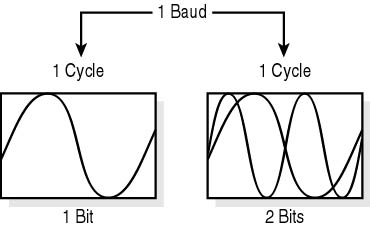Baud Rate
As mentioned earlier, baud rate refers to how fast a modem can transmit data. Technically, the baud is the number of voltage or frequency changes that can be made in one second. When a modem is working at 300 baud, this means that the basic carrier frequency has 300 cycles per second. Due to restrictions imposed by the physics of the wiring, a dial-up phone line can go up to 2400 cycles, a baud rate of 2400.
If each cycle is one bit, the fastest rate at which data can be transmitted is2400 bps. However, by using different types of modulation, more than one bit can be transmitted per cycle. Earlier modems used the baud rate to measure their speed. (See Figure 12.7.)

Figure 12.7 Baud
Bits per Second
The actual modem speed, or rate, that data is transmitted, is measured in bits per second. If a modem modulates one bit for each baud cycle, then the modem speed is 2400 bps. If a 2400-baud modem modulates two bits for one cycle of time, the modem is said to have a speed of 4800 bps (not a baud rate of 4800). If four bits are modulated with one cycle of time, then a modem speed of 9600 bps is achieved.
NOTE
Do not confuse baud with bps.
Modem speed standards are designated by the Comit� Consultatif T�l�graphique et T�l�phonique (CCITT), an international body that develops fax and modem standards. The CCITT is now a branch of the International Telecommunications Union-Telecommunication Standardization Sector (abbreviated as ITU-T). The following table lists the standard rates designated by the CCITT.
| CCIT Term | bps |
|---|---|
| V.21 | 300 |
| V.22 | 1200 |
| V.22bis | 2400 |
| V.23 | 1200 bps in one direction and 75 bps in the other |
| V.29 | 9600 |
| V.32 | 4800 and 9600 |
| V.32bis | 14,400 |
| V.32fast | 28,800 |
| V.34 | 28,800 |
| V.42bis | 38,400 |
NOTE
The term "bis" refers to the second revision of the standard.